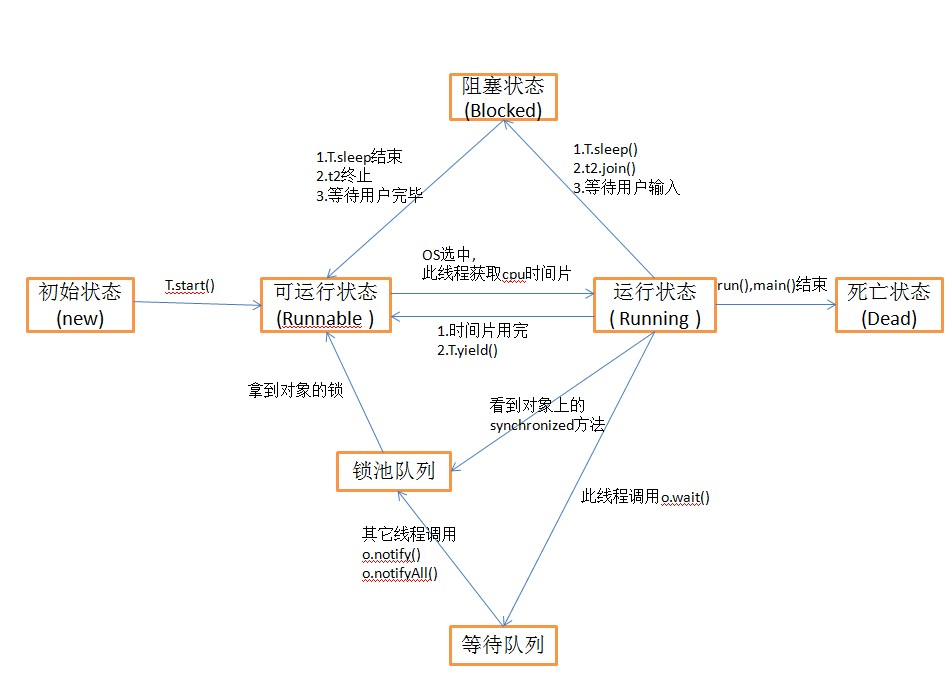参考文章:
Java线程的5种状态及切换:http://blog.csdn.net/pange1991/article/details/53860651
线程的5种状态:
1. 新建(NEW):新创建了一个线程对象。
2. 可运行(RUNNABLE):线程对象创建后,其他线程(比如main线程)调用了该对象的start()方法。该状态的线程位于可运行线程池中,等待被线程调度选中,获取cpu 的使用权
3. 运行(RUNNING):可运行状态(runnable)的线程获得了cpu 时间片(timeslice) ,执行程序代码。
4. 阻塞(BLOCKED):阻塞状态是指线程因为某种原因放弃了cpu 使用权,也即让出了cpu timeslice,暂时停止运行。直到线程进入可运行(runnable)状态,才有机会再次获得cpu timeslice 转到运行(running)状态。阻塞的情况分三种:
(1). 等待阻塞:运行(running)的线程执行o.wait()方法,JVM会把该线程放入等待队列(waitting queue)中。
(2). 同步阻塞:运行(running)的线程在获取对象的同步锁时,若该同步锁被别的线程占用,则JVM会把该线程放入锁池(lock pool)中。
(3). 其他阻塞:运行(running)的线程执行Thread.sleep(long ms)或t.join()方法,或者发出了I/O请求时,JVM会把该线程置为阻塞状态。当sleep()状态超时、join()等待线程终止或者超时、或者I/O处理完毕时,线程重新转入可运行(runnable)状态。
5. 死亡(DEAD):线程run()、main() 方法执行结束,或者因异常退出了run()方法,则该线程结束生命周期。死亡的线程不可再次复生
线程的状态切换图


/** * 计算输出其他线程锁计算的数据 * */ public class ThreadA { public static void main(String[] args) throws InterruptedException{ ThreadB b = new ThreadB(); //启动计算线程 b.start(); //线程A拥有b对象上的锁。线程为了调用wait()或notify()方法,该线程必须是那个对象锁的拥有者 synchronized (b) { System.out.println("等待对象b完成计算。。。"); //当前线程A等待 b.wait(); System.out.println("b对象计算的总和是:" + b.total); } } } /** * 计算1+2+3 ... +100的和 * */ class ThreadB extends Thread { int total; public void run() { synchronized (this) { for (int i = 0; i < 101; i++) { total += i; } //(完成计算了)唤醒在此对象监视器上等待的单个线程,在本例中线程A被唤醒 notify(); System.out.println("计算完成"); } } }
为什么进入wait和notify的时候要加synchronized锁?
通俗的解释: 只有两个线程抢一个资源的时候才存在两个线程同一时刻只能有一个线程得到资源,锁就是为了使两个线程抢同一个资源,如果没有锁,意思是两个线程不存在抢资源情况,那两个线程凭什么你等我 我等你,早就一起跑了
wait方法执行后未退出同步块,其他线程如何进入同步块?
执行wait,会释放锁
为什么wait方法可能抛出InterruptedException异常?
为了可以中断线程?
notify执行之后立马唤醒线程吗?
不会。默认是先退出同步块才真正的唤醒等待线程
中断线程
每一个线程都有一个boolean类型标志,用来表明当前线程是否请求中断,当一个线程调用interrupt() 方法时,线程的中断标志将被设置为true。
我们可以通过调用Thread.currentThread().isInterrupted()或者Thread.interrupted()来检测线程的中断标志是否被置位。这两个方法的区别是
Thread.currentThread().isInterrupted()是线程对象的方法,调用它后不清除线程中断标志位;而Thread.interrupted()是一个静态方法,调用它会清除
线程中断标志位。
所以说调用线程的interrupt() 方法不会中断一个正在运行的线程,这个机制只是设置了一个线程中断标志位,如果在程序中你不检测线程中断标志位,那么即使
设置了中断标志位为true,线程也一样照常运行。
中断线程分为三种情况:
中断非阻塞线程
中断非阻塞线程通常有两种方式:
(1)采用线程共享变量
这种方式比较简单可行,需要注意的一点是共享变量必须设置为volatile,这样才能保证修改后其他线程立即可见

public class InterruptThreadTest extends Thread{ // 设置线程共享变量 volatile boolean isStop = false; public void run() { while(!isStop) { long beginTime = System.currentTimeMillis(); System.out.println(Thread.currentThread().getName() + "is running"); // 当前线程每隔一秒钟检测一次线程共享变量是否得到通知 while (System.currentTimeMillis() - beginTime < 1000) {} } if (isStop) { System.out.println(Thread.currentThread().getName() + "is interrupted"); } } public static void main(String[] args) { // TODO Auto-generated method stub InterruptThreadTest itt = new InterruptThreadTest(); itt.start(); try { Thread.sleep(5000); } catch (InterruptedException e) { // TODO Auto-generated catch block e.printStackTrace(); } // 线程共享变量设置为true itt.isStop = true; } }
(2) 采用中断机制

public class InterruptThreadTest2 extends Thread{ public void run() { // 这里调用的是非清除中断标志位的isInterrupted方法 while(!Thread.currentThread().isInterrupted()) { long beginTime = System.currentTimeMillis(); System.out.println(Thread.currentThread().getName() + "is running"); // 当前线程每隔一秒钟检测线程中断标志位是否被置位 while (System.currentTimeMillis() - beginTime < 1000) {} } if (Thread.currentThread().isInterrupted()) { System.out.println(Thread.currentThread().getName() + "is interrupted"); } } public static void main(String[] args) { // TODO Auto-generated method stub InterruptThreadTest2 itt = new InterruptThreadTest2(); itt.start(); try { Thread.sleep(5000); } catch (InterruptedException e) { // TODO Auto-generated catch block e.printStackTrace(); } // 设置线程的中断标志位 itt.interrupt(); } }
中断阻塞线程
当线程调用Thread.sleep()、Thread.join()、object.wait()再或者调用阻塞的i/o操作方法时,都会使得当前线程进入阻塞状态。那么此时如果在线程处于阻塞状态是调用
interrupt() 方法设置线程中断标志位时, 处于阻塞状态的线程会抛出一个异常,并且会清除线程中断标志位(设置为false)。这样一来线程就能退出
阻塞状态。当然抛出异常的方法就是造成线程处于阻塞状态的Thread.sleep()、Thread.join()、object.wait()这些方法。

public class InterruptThreadTest3 extends Thread{ public void run() { // 这里调用的是非清除中断标志位的isInterrupted方法 while(!Thread.currentThread().isInterrupted()) { System.out.println(Thread.currentThread().getName() + " is running"); try { System.out.println(Thread.currentThread().getName() + " Thread.sleep begin"); Thread.sleep(1000); System.out.println(Thread.currentThread().getName() + " Thread.sleep end"); } catch (InterruptedException e) { // TODO Auto-generated catch block //由于调用sleep()方法清除状态标志位 所以这里需要再次重置中断标志位 否则线程会继续运行下去 Thread.currentThread().interrupt(); e.printStackTrace(); } } if (Thread.currentThread().isInterrupted()) { System.out.println(Thread.currentThread().getName() + "is interrupted"); } } public static void main(String[] args) { // TODO Auto-generated method stub InterruptThreadTest3 itt = new InterruptThreadTest3(); itt.start(); try { Thread.sleep(5000); } catch (InterruptedException e) { // TODO Auto-generated catch block e.printStackTrace(); } // 设置线程的中断标志位 itt.interrupt(); }
不可中断线程
有一种情况是线程不能被中断的,就是调用synchronized关键字和reentrantLock.lock()获取锁的过程
线程间的协作
object类的方法wait/notify/notifyAll
wait():
作用于持有该对象锁的当前线程,使线程从运行态,进入到等待阻塞状态,释放对象锁,释放cpu控制权,调用该方法的前提是获得对象锁
notify()/notifyAll:
作用于持有该对象锁的线程(其中一个/全部),使线程从等待阻塞状态,进入到锁池阻塞状态,调用该方法的前提是获得对象锁
Thread类的方法sleep/yield/join
sleep():
作用于当前线程,使其进入阻塞状态,释放cpu,时间到了即可唤醒,唤醒后进入就绪状态
yield():
作用于当前线程,使其进入就绪状态,暂时释放cpu,下个抢到cpu的还可能是该线程本身。(意图是让相同优先级的其他线程有机会拿到cpu)
join():
作用于当前线程,使其进入阻塞状态,释放cpu,直到线程t(t.join())执行完毕。(源码是通过wait方法实现的)
wait/notify/notifyAll方法的作用是实现线程间的协作,那为什么这三个方法不是位于Thread类中,而是位于Object类中?
位于Object中,也就相当于所有类都包含这三个方法(因为Java中所有的类都继承自Object类)
要回答这个问题,还是得回过来看wait方法的实现原理,大家需要明白的是,wait等待的到底是什么东西?wait等待的其实是对象monitor,由于Java中的每一个对象都有一个内置的monitor对象,自然所有的类都理应有wait/notify方法。
